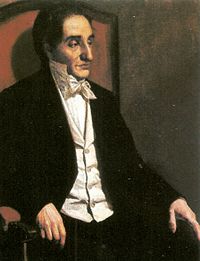Francisco Antonio Zea
| Francisco Antonio Zea Díaz | |
|---|---|

1874 painting of Francisco Antonio Zea
|
|
| 1st Envoy Extraordinary and Minister Plenipotentiary of Colombia to the United Kingdom | |
|
In office 16 June 1820 – 28 November 1822 |
|
| President | Simón Bolívar Palacios |
| Preceded by | Office created |
| Succeeded by | José Fernández Madrid |
| 1st Vice President of Colombia | |
|
In office 17 December 1819 – 21 March 1820 |
|
| President | Simón Bolívar Palacios |
| Preceded by | Office created |
| Succeeded by | Francisco de Paula Santander y Omaña |
| President of the Congress of Angostura | |
|
In office 15 February 1819 – 7 September 1819 |
|
| Deputy | Diego de Vallenilla |
| Personal details | |
| Born |
Juan Francisco Antonio Hilarión Zea Díaz 23 November 1766 Medellín, Antioquia, Viceroyalty of New Granada |
| Died | 28 November 1822 (aged 56) Bath, Somerset, England, United Kingdom of Great Britain and Ireland |
| Resting place |
Bath Abbey 51°22′51″N 2°21′33″W / 51.38083°N 2.35917°W |
| Nationality | Neogranadine |
| Spouse(s) | Felipa Meilhon Montemayor |
| Children | Felipa Zea Meilhon, Viscountess of Rigny |
| Occupation | Diplomat, botanist |
| Religion | Roman Catholic |
Juan Francisco Antonio Hilarión Zea Díaz (born 23 November 1766 – 28 November 1822) was a Colombian journalist, botanist, diplomat, politician, and statesman who served as the 1st Vice President of Colombia under then President Simón Bolívar. He was also Ambassador of Colombia to the United Kingdom where he tried in vain to gain recognition for the nascent nation of Colombia.
Francisco Antonio Zea was born to Pedro Rodríguez de Zea Casafus, a Spaniard from Marchena, Seville, and María Rosalia Ignacia Díaz Peláez whose paternal family hailed from Asturias while her maternal side was a well established Criollo Paisa family. He was baptised on 23 November 1766 with the name Juan Francisco Antonio Hilarión Zea Díaz.
Zea married in Madrid in 1805 to Felipa Meilhon y Montemayor, a gaditana born in 1788, daughter of Juan Antonio Meilhon, a native of Béarn, France, and Antonia Montemayor, native of Ronda, Málaga. Out of this marriage was born only one daughter, Felipa Antonia Zea Meilhon, who would later become Viscountess of Rigny after marrying Alexander Gaulthier, Viscount of Rigny, son of Henri, Count of Rigny. His widow died in Madrid in 1833, and his daughter then-window of Rigny, died on 4 September 1887 at the Château de Fougères.
Zea began his education in Medellín, afterwards he travelled to the Real Colegio y Seminario de Popayán, where his distant relative José Félix de Restrepo was a professor. In the Seminary he became acquainted with other young Neogranadines who would go on to become precursors and martyrs of the independence such as Francisco José de Caldas, Camilo Torres Tenorio, Francisco Antonio Ulloa, and José María Cabal. He finished his studies in 1785, and although his father wanted him to continue his ecclesiastical studies, Zea moved the next year to Bogotá in hopes of studying jurisprudence, goal which he attained by applying and receiving a scholarship from the Colegio Mayor de San Bartolomé. He had to endure poverty and sickness, to the point that he was expelled for not being able to pay his pension. He was able to continue his studies with the help of Gabriel Muñoz, and in 1788 he became an adjunct professor of grammar and in 1789 adjunct professor of philosophy, positions which allowed him to improve his living situation. Maybe it was his love of teaching, or his need and desire for a stable income, but he decided to postpone his degree to teach full-time, degree which he never did achieve. He became renowned as a tutor to the extent that Viceroy José Manuel de Ezpeleta hired him as a private tutor for his children.
...
Wikipedia
